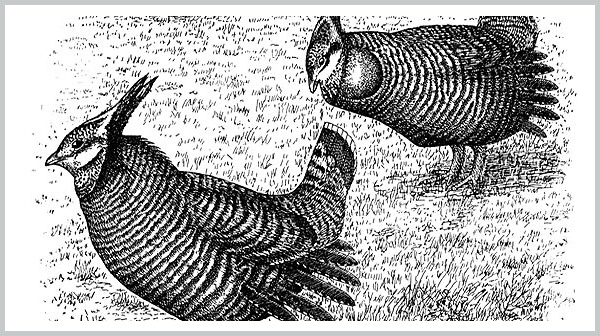
Heath Hen
Name: Heath Hen (Tympanuchus cupido cupido)
Conservation Status: Extinct
The heath hen, a small wild fowl, was a relative of the prairie chicken. It was once considered quite tasty and was rather easy to kill. Prior to the American Revolution, the heath hen was found in the eastern United States from Maine to Virginia. But expanding human populations in the colonies put an intolerable hunting pressure on hen’s populations, which noticeably lowered heath hen populations by the time of the Revolutionary War.
In 1830 the heath hen’s precipitous decline garnered the attention of naturalist John Audubon (founder of The Audubon Society), but it continued unabated. By the 1870s the only heath hens left, occupied a tiny island called Martha’s Vineyard off the coast of Cape Cod in Massachusetts.
In 1907 there were only 50 heath hens left on Martha’s Vineyard. The following year a 1600-acre sanctuary was established for their protection.
Protection at the sanctuary seemed to be successful. The original 50 protected birds reproduced rapidly and there were 2,000 individuals by 1915. The entire heath hen population, however, was still confined to Martha’s Vineyard. Then disaster struck. In 1916 a fire wiped out much of the habitat that heath hens used for breeding.
The following winter was unusually harsh, and an influx of goshawks, a predatory bird that fed on the heath hens, hurt the population even more. Finally, many of the remaining heath hens fell victim to a poultry disease brought to the island by domestic turkeys.
There were only 13 heath hens left by 1927 and most of these were males. The last living heath hen, the final survivor of his species, was seen on March 11, 1932. He died that year.
Why did the heath hen become extinct? There is no simple answer to this question. The last birds were wiped out by a series of relatively common, but deadly, natural events: fire, starvation, predation, and disease.
But the heath hen’s continued existence as a species would not have been so vulnerable to these occurrences if their populations had not been severely reduced already by human hunting. In its former range, the heath hen easily could have survived any one of these stresses, or even all of them in combination.
The story of the heath hen’s demise shows how reductions in geographic range and population size caused by human activities can make a species vulnerable to natural events over which humans have little or no control. It also shows that designating a protective zone, or prohibiting the direct killing of an endangered species, does not guarantee survival of the species.
Questions for Thought:
The first paragraph above describes the heath hen’s decline from pre-Revolutionary times to the year in which the remaining birds were protected. Does this part of the story remind you of any of the endangered animals you have read about? Which endangered species have severely reduced geographic ranges?
Which endangered species are protected in small numbers in a concentrated area? Which species are believed to have, or to have had at one time, fewer than 50 individuals left?
Why might the fact that in 1927 the 13 remaining birds were mostly male (11 males and 2 females) be important in what happened to the heath hen?
Martha’s Vineyard is an island. What aspects of island biogeography may have affected the heath hen?
Of the factors discussed in the heath hen’s extinction, which one do you think is the most important and why?
Can the poultry disease that was brought by domestic turkeys be considered an anthropogenic factor? Which of the other seemingly natural factors might have an anthropogenic component?
What needed to be done to protect the heath hen? How would earlier intervention to preserve the heath hen have differed from later intervention?
Related Classroom Activities
[CS2-8,C3-1,C3-2, General]